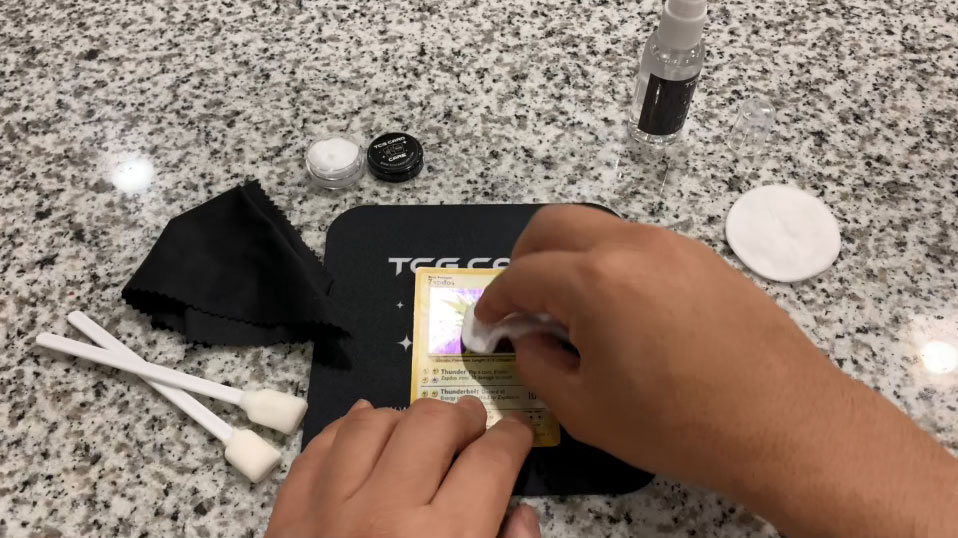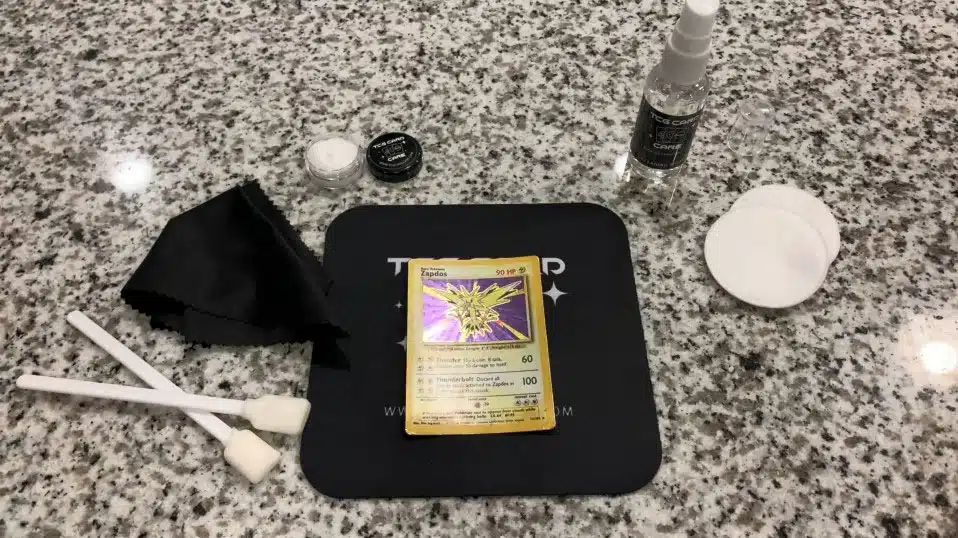For trading card collectors, the condition of each card is a crucial aspect of its value and desirability. Whether you’re collecting Pokémon cards, sports cards, Magic: The Gathering cards, or any other type of trading card, the presence of unwanted marks, such as texta (marker) ink, pen marks, or other blemishes, can significantly reduce a card’s appeal and market value.
These marks are often the result of accidents, careless handling, or even previous owners who may not have been as meticulous about card preservation.
Removing these marks without damaging the card is a delicate and often nerve-wracking process, particularly when dealing with high-value or sentimental cards.
The key to successfully removing marks from trading cards lies in understanding the card’s material, the type of mark, and using the right techniques and tools.
In this comprehensive guide, we’ll delve deeply into the process of safely removing unwanted marks from your trading cards while minimizing the risk of damage, preserving both the aesthetic and financial value of your collection.

1. Understanding the Types of Marks and Card Materials
Before attempting to remove any mark from a trading card, it’s essential to assess both the nature of the mark and the card’s material. Different marks react differently to cleaning methods, and trading cards vary widely in terms of their surface treatment and material composition.
a) Types of Marks
- Permanent Marker (Texta): Permanent markers are designed to be resistant to fading and smudging, making them particularly challenging to remove. These marks can penetrate the surface of the card, especially on more porous materials, requiring careful treatment to avoid further damage.
- Non-Permanent Marker: These markers are water-soluble, meaning they can sometimes be removed with simple cleaning solutions. However, the risk of smudging and spreading the ink across the card’s surface is high, so they still require careful handling.
- Ballpoint Pen: Ballpoint pen marks are often more indented into the card due to the pressure applied during writing. Removing pen marks involves not just lifting the ink but also potentially dealing with the indentations left on the card’s surface.
- Stains and Smudges: These can come from various sources, such as dirt, oils, or food. The approach to removing stains varies depending on the nature of the stain and how deeply it has penetrated the card.
b) Card Materials and Surface Finishes
- Glossy Cards: Glossy trading cards have a protective coating that makes them more resistant to liquid penetration and easier to clean. However, this glossy surface can also be prone to smudges and scratches during the cleaning process.
- Matte Cards: Matte cards lack the protective glossy coating, making them more vulnerable to absorbing ink and liquids. These cards require a gentler approach, as they can be easily damaged by aggressive cleaning methods.
- Vintage Cards: Older cards may have different surface treatments compared to modern cards. They might be more fragile, and their finishes can be more susceptible to wear and tear. Extra care is needed when cleaning vintage cards, as their materials may not react well to modern cleaning solutions.
Understanding these factors will guide your choice of cleaning method and help you avoid unintentionally damaging your card during the process.
2. Essential Tools and Materials for Card Cleaning
Having the right tools and materials is critical to successfully removing marks from trading cards. Below is a list of items you’ll need to perform the cleaning process effectively and safely:
a) Isopropyl Alcohol (70% or 90%)
Isopropyl alcohol is a common solvent that can help lift certain types of ink, particularly those from non-permanent markers and some types of ballpoint pens. The concentration of the alcohol matters: 70% is safer for most applications, while 90% may be more effective but should be used with caution due to its stronger solvent properties.
b) Cotton Swabs
Cotton swabs are ideal for applying cleaning solutions in a controlled and precise manner. They allow you to target small areas without affecting the surrounding parts of the card. It’s best to use high-quality cotton swabs that don’t shed fibers easily, as loose fibers can stick to the card’s surface during the cleaning process.
c) Microfiber Cloth
A microfiber cloth is essential for wiping the card gently without causing scratches. Unlike regular cloths, microfiber is soft enough to clean delicate surfaces without leaving residue or causing additional damage.
d) Vinyl or Art Gum Eraser
Erasers can be used to remove certain surface marks, especially those made with non-permanent markers or pencils. A vinyl eraser is firm and precise, making it useful for targeted cleaning, while an art gum eraser is softer and less abrasive, ideal for more delicate tasks.
e) Distilled Water
Distilled water is used to dilute alcohol or for a final rinse after cleaning. It’s free from minerals and impurities that could leave residue on the card. Always use distilled water rather than tap water to avoid introducing any additional contaminants.
f) Rubber Gloves
Wearing rubber gloves prevents the oils and dirt from your hands from transferring to the card during cleaning. Gloves also protect your skin from exposure to cleaning chemicals.

3. Step-by-Step Guide to Safely Removing Marks
Now that you have the necessary tools and a clear understanding of the different types of marks and card materials, it’s time to proceed with the cleaning process. Follow these steps carefully to maximize your chances of successfully removing the mark without damaging the card.
a) Test on a Less Valuable Card
Before applying any cleaning method to a valuable or rare card, it’s crucial to test the method on a less valuable card made of similar material and finish. This will give you a better idea of how the card will react to the cleaning process and help you refine your technique before moving on to more important cards.
b) Using Isopropyl Alcohol for Surface Marks
Isopropyl alcohol is effective for removing surface-level marks on glossy cards. Here’s how to use it:
- Dilute if Necessary: Depending on the type of mark and the card material, you may want to dilute the isopropyl alcohol with distilled water (especially if you’re using 90% alcohol). A 1:1 ratio is a good starting point for dilution.
- Dampen a Cotton Swab: Lightly dampen a cotton swab with the alcohol solution. The swab should be moist, not soaked, to prevent excessive liquid from spreading or seeping into the card.
- Gently Dab the Mark: Carefully dab the cotton swab on the mark. Avoid rubbing or applying too much pressure, as this can spread the ink or damage the card’s surface. Work in small sections, and be patient.
- Wipe with a Microfiber Cloth: After each dab, gently wipe the area with a clean microfiber cloth to remove any lifted ink and excess alcohol. This helps prevent the mark from reabsorbing into the card.
- Repeat the Process: If the mark isn’t fully removed after the first attempt, repeat the process as needed. However, avoid overworking the area, as repeated applications can wear down the card’s finish or cause discoloration.
c) Using a Vinyl Eraser for Non-Porous Surfaces
A vinyl eraser is a useful tool for removing marks from cards with non-porous, glossy surfaces. Here’s how to use it:
- Lightly Erase the Mark: Gently rub the mark with the eraser, moving in one direction. Applying too much pressure or using a back-and-forth motion can smudge the mark or scratch the card.
- Clean Residue: After erasing, use a microfiber cloth to remove any eraser residue. This step is important to ensure that no particles are left behind that could scratch the card when placed in a sleeve or binder.
- Monitor for Damage: Continually check the card for any signs of damage, such as dulling of the surface or faint scratches. If you notice any adverse effects, stop using the eraser immediately.
d) Avoid Water-Based Solutions on Matte or Older Cards
Matte cards and older cards are more susceptible to water damage due to their porous nature. Using water-based solutions can cause the card to warp, discolor, or develop water stains. If you must use a liquid, apply it sparingly, and always test on a less valuable card first.
For older cards, consider using a dry cleaning method, such as a vinyl or art gum eraser, to avoid the risk of water damage.

4. Advanced Techniques for Stubborn Marks
If basic cleaning methods aren’t sufficient to remove stubborn marks, you may need to employ more advanced techniques. However, these methods carry a higher risk of damage and should be used with caution.
a) Using a Magic Eraser
A Magic Eraser (melamine foam) is an abrasive cleaning pad that can remove tough marks. However, because it’s abrasive, it can also strip the card’s surface if not used carefully.
- Dampen the Magic Eraser: Lightly dampen a small piece of the Magic Eraser with distilled water. Ensure it’s not too wet, as excess moisture can damage the card.
- Gently Rub the Mark: Lightly rub the mark with the Magic Eraser, using minimal pressure. Focus on the marked area only, and avoid rubbing the surrounding surface.
- Wipe the Area: After using the Magic Eraser, immediately wipe the area with a microfiber cloth to remove any residue.
- Monitor the Surface: Regularly check the card’s surface to ensure that the Magic Eraser isn’t causing damage. If you notice any dulling or scratching, stop immediately.
b) Professional Restoration Services
For highly valuable cards with significant marks, professional restoration services might be the best option. These services use specialized equipment and techniques to remove marks while preserving the integrity of the card. While this option can be expensive, it’s worth considering for rare cards that are heavily marked or damaged.
5. Precautions and Best Practices
Removing marks from trading cards is a process that requires precision, patience, and care. Here are some additional tips and precautions to keep in mind:
- Work in a Clean Environment: Ensure your workspace is clean and free of dust and debris that could contaminate the card or cause scratches during the cleaning process.
- Avoid Over-Cleaning: It can be tempting to continue cleaning in pursuit of perfection, but over-cleaning can lead to damage. Know when to stop to avoid making the problem worse.
- Protect Cards After Cleaning: Once you’ve successfully removed a mark, protect the card by placing it in a card sleeve or top loader. This prevents future damage and keeps the card in its best possible condition.
- Use Minimal Liquid: When using liquids like isopropyl alcohol, apply them sparingly to avoid saturation. Excessive liquid can seep into the card’s layers, causing warping, discoloration, or other irreversible damage.
- Consider the Card’s Value: Always weigh the risk of attempting to clean a card against its value. For particularly valuable cards, it may be safer to consult a professional rather than risk causing further damage.
6. When to Seek Professional Help
There are situations where attempting to remove marks yourself may not be advisable. If the mark is on a particularly valuable or rare card, or if you’re uncertain about how to proceed, seeking professional help is often the best course of action.
a) Professional Card Restoration Services
Professional card restoration services have the tools, expertise, and experience to safely remove marks and restore cards to their original condition. These services can be especially useful for vintage or high-value cards where the risk of damage is too great to attempt DIY cleaning.
b) Costs and Considerations
Professional restoration can be costly, so it’s important to weigh the benefits against the potential increase in the card’s value. For very rare cards, the investment in professional cleaning and restoration may be well worth the cost.
Removing unwanted marks from trading cards is a delicate process that, when done correctly, can significantly enhance the appearance and value of your collection.
By understanding the types of marks and the materials of your cards, using the right tools and techniques, and knowing when to seek professional help, you can effectively restore your cards without causing damage.
Remember, patience and caution are key. Work slowly, test methods on less valuable cards first, and always prioritize the long-term preservation of your collection.
With the right approach, you can maintain the pristine condition of your trading cards and enjoy the satisfaction of a well-preserved collection.
Happy collecting!




